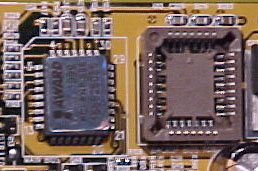Gigabyte GA-6WMM7 i810 Socket-370 microATX
by Mike Andrawes on July 21, 1999 12:28 AM EST- Posted in
- Motherboards
The ATX specification is also closely followed with all major components strategically placed to minimize cable clutter and provide the most room to work around the board. All HDD/FDD connectors are located where they should be, right at the front of the board, so that no cables are forced to run over the CPU and/or memory. Just about all connectors are color coded, as per the PC99 specifications. Primary IDE is blue, while secondary IDE white to make identification at a glance possible. Of course, the backpanel features the rainbow of colors required for PC99 compliance. The ATX power connector is right behind the DIMM slots, but still far enough forward to allow adequate air flow over the CPU from the power supply. The board is an average sized microATX and should fit fine in any microATX or ATX case.
A nice touch is the inclusion of a header for front USB ports. However, the cables aren't included, but then again how many cases can accept them without cutting a custom hole? When the front ports are enabled, the onboard rear ports are disabled. Gigabyte has also included an upgrade connector that a 34-pin connector that looks surprisingly like a FDD connector (because it is) for TV/DFP LCD output upgrades. A 9 pin header is included for adding the second COM port that is not available on the ATX shield due to the onboard VGA connector. Three fan headers are included, two by the CPU and one at the front of the board.
Complete hardware monitoring is included on the GA-6WMM7 through the Winbond 83782D chip and monitors 3 fan speeds, 9 voltages, and up to 3 temperatures. The 83782D improves upon the older Winbond 83781 by including a provision to read CPU temperature straight from the on-die thermal diode for the most accurate CPU readings possible. The 9 voltages measured include VGTL, +5VSB, and battery voltage, in addition to the standard +/- 5V, +/- 12V, +3.3V, and Vcore.
The reason for "up to 3 temperatures" is that the Winbond hardware monitor can only monitor two temperatures on its own - the temperature of the Winbond chip itself and the CPU's thermal diode (where available, which in the case of Socket-370 CPU's, is always). In order to monitor the other temperature, the Winbond chip requires an external thermistor. There is no place to connect a thermistor, so with this board, you're stuck with just two temperatures - the CPU and system temperatures.
Gigabyte takes things one step further by allowing the system to be shut down if the CPU temperature exceeds a user defined value in the BIOS. This can of course be disabled as well if erroneous readings ever crop up and cause problems. Alarms for overheating and fan failure are also available via the BIOS. To top the hardware monitoring off, the core voltage and CPU ID are proudly announced upon bootup just before the memory check - a nice touch by Gigabyte.
Speaking of that BIOS, Gigabyte has also taken the new Award 6.00PG BIOS found on i810 boards and improved upon it just a bit, starting off with a feature well known on AOpen boards - a set of BIOS options that can be loaded and are already tweaked for performance. These options pretty much are optimal for the majority of users, but if you're a real hardcore tweaker, you'll want to go through and double check that everything set the way you like it. SDRAM CAS latency can be configured to 2 or 3 manually, or just left to be ready off the SDRAM SPD.
 Gigabyte's
Dual BIOS, first seen on their BX2000,
is optional on the GA-6WMM7. The feature is designed to prevent any form of
BIOS corruption due to viruses, incorrect flashing, etc. by including a backup
of the BIOS on a second flash ROM that can be restored at any time. In theory,
it is capable of booting from the non damaged BIOS automatically if something
should ever happen. AnandTech's evaluation sample did not include the backup
BIOS, so we could not try it ourselves, but the procedure has worked on the
BX2000.
Gigabyte's
Dual BIOS, first seen on their BX2000,
is optional on the GA-6WMM7. The feature is designed to prevent any form of
BIOS corruption due to viruses, incorrect flashing, etc. by including a backup
of the BIOS on a second flash ROM that can be restored at any time. In theory,
it is capable of booting from the non damaged BIOS automatically if something
should ever happen. AnandTech's evaluation sample did not include the backup
BIOS, so we could not try it ourselves, but the procedure has worked on the
BX2000.










0 Comments
View All Comments